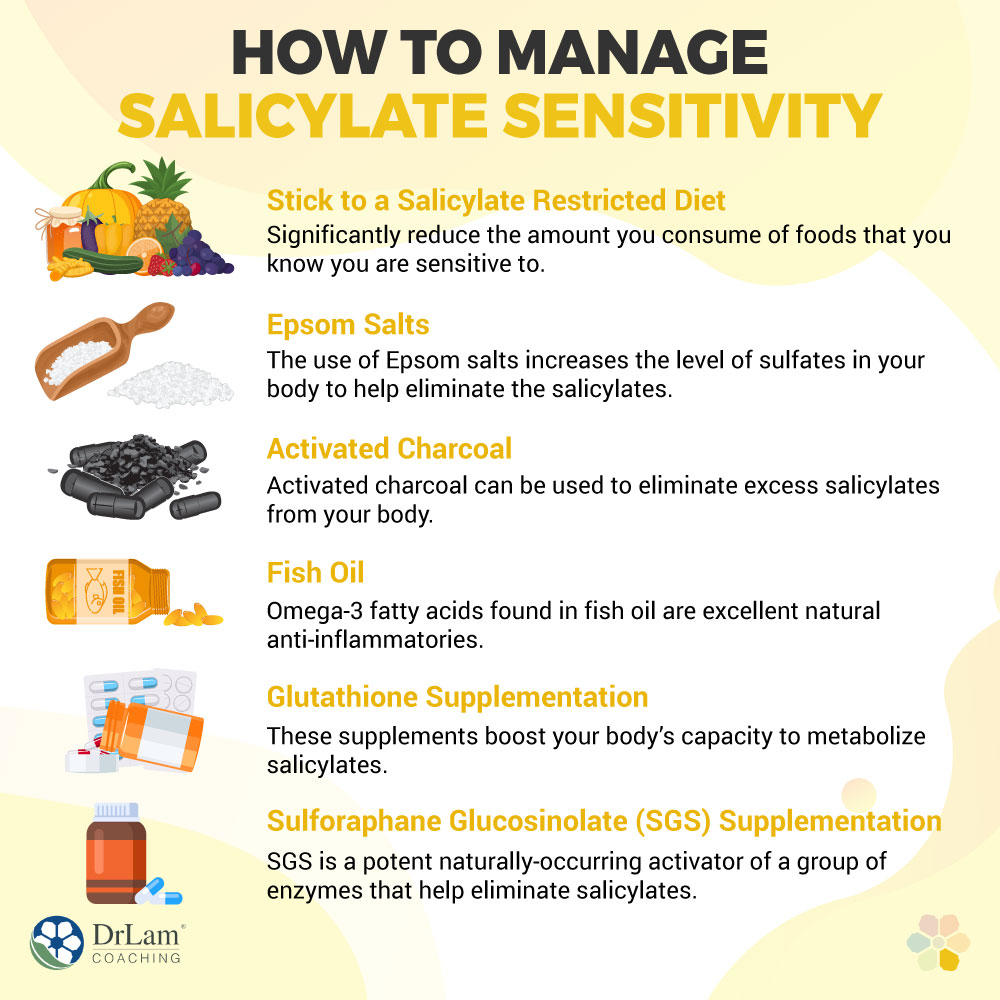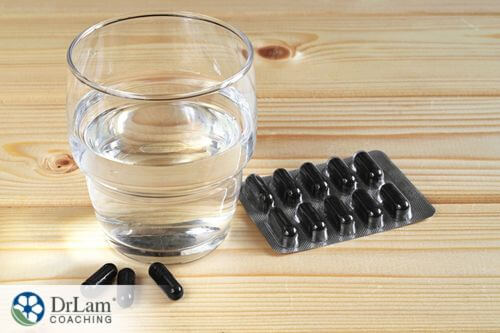 You may not have heard of salicylate sensitivity, but it affects many people, including those with asthma and autism. Initially, many are unaware that the symptoms they are experiencing are linked to this condition. Most people attribute them to some other food sensitivity. But salicylate exposure can cause an inflammatory reaction and lead to multiple symptoms. And knowing whether you have this sensitivity is key to putting you in a better position to manage it.
You may not have heard of salicylate sensitivity, but it affects many people, including those with asthma and autism. Initially, many are unaware that the symptoms they are experiencing are linked to this condition. Most people attribute them to some other food sensitivity. But salicylate exposure can cause an inflammatory reaction and lead to multiple symptoms. And knowing whether you have this sensitivity is key to putting you in a better position to manage it.
Salicylates are a kind of phenol that’s found naturally in all kinds of plants. They function as a natural hormone, as well as a preservative. Salicylates are stored in plant barks, leaves, seeds, and roots, and protect these plants from bacteria, fungi, and insects. Many of the foods you consume contain salicylates. Sensitivities can develop to these substances.
Natural salicylates are found in a variety of foods, such as fruits, vegetables, coffee, honey, nuts, teas, and spices. Raw or dried foods and fruit juices contain higher amounts of salicylates than other sources. When the food is cooked, the level of salicylates is lowered. Salicylates are also present in beauty and cosmetic products, as well as medications (e.g. aspirin). Salicylates can also be found in flavored products such as chewing gum, sweets, and toothpaste. They can also be found in artificial coloring and flavoring.
Salicylate sensitivity is a kind of allergic reaction to foods containing salicylates. It involves the body’s inability to tolerate more than a certain amount of the substance salicylate at any given time. Individuals experiencing this sensitivity may be unable to eat particular vegetables or fruits or some salicylate-containing products.
This sensitivity varies significantly from person to person. It’s impossible to accurately predict who will be impacted, when the issue will emerge, and the extent to which an individual will be affected. It is strongly linked to asthma and inflammation as well.
Salicylate sensitivity is believed to be the result of an overproduction of leukotrienes. These are inflammatory mediators that accumulate when cyclooxygenase inhibition occurs. Cyclooxygenase is the mechanism behind salicylate activity. It inhibits the action of two enzymes that are usually responsible for converting arachidonic acid, an essential fatty acid, into prostaglandins and leukotrienes. When disruption of prostaglandins production occurs, an increase in leukotrienes production takes place.
For individuals who are sensitive to leukotrienes, symptoms related to salicylate sensitivity may develop or other health problems. Leukotrienes have been linked to a wide range of conditions, such as allergic rhinitis, anaphylaxis, asthma, interstitial lung diseases, and rheumatoid arthritis.
While chronic sensitivity to salicylates is not officially recognized, nonetheless, it’s a common source of health issues. This is especially true for elderly individuals and those with a weakened immune system. The symptoms of chronic sensitivity are typically varied and they are usually nonspecific.
Research shows many people with chronic health conditions, such as asthma, food allergies, irritable bowel syndrome, and behavioral issues may be sensitive to salicylates to a certain degree.
 Salicylates can easily and quickly penetrate the blood-brain barrier because of the ratio of fat to water present in the cell membranes. Symptoms of salicylate sensitivity may emerge anywhere from twenty minutes to two hours following the ingestion of food containing salicylates. Many of the symptoms of salicylate sensitivity mimic those found in Adrenal Fatigue Syndrome (AFS). The severity of symptoms varies from one person to the next.
Salicylates can easily and quickly penetrate the blood-brain barrier because of the ratio of fat to water present in the cell membranes. Symptoms of salicylate sensitivity may emerge anywhere from twenty minutes to two hours following the ingestion of food containing salicylates. Many of the symptoms of salicylate sensitivity mimic those found in Adrenal Fatigue Syndrome (AFS). The severity of symptoms varies from one person to the next.
Physical symptoms include:
Mental symptoms include:
There are some individuals who are more susceptible to developing salicylate sensitivity than others. These include:
If you experience salicylates sensitivity, it’s best to avoid food triggers. However, keep in mind that the level of salicylate in a particular food can be impacted by factors such as the level of ripeness, growing conditions, and preparation. Fruits, vegetables, and spices typically contain a level of this phenol.
There are certain foods that are high in salicylates that you should abstain from. Foods to avoid include:
This is not an exhaustive list, but these are some of the many food sources of salicylates. As such, proactive dietary changes are perhaps the healthiest approach to tackling salicylate sensitivities. Opting for a low salicylate diet is a solid step toward managing salicylate intake.
Salicylates are also found in a variety of non-food products, from medications to cosmetics. These include:
It’s typical for conventionally trained physicians to miss or overlook the nonspecific symptoms of both salicylate sensitivity and AFS, and both overlap. As such, a comprehensive approach is often needed to make the correct assessment and manage the condition. The metabolic system is impacted by salicylate sensitivity. When the symptoms overlap with AFS, often the Inflammation and the Detoxification circuit of the NeuroEndoMetabolic (NEM) stress response are dysregulated.
When the symptoms of AFS or salicylates sensitivity emerge, you may not have any memory of eating the trigger food. However, your adrenal glands are involved in responding to the sensitivity. This indicates that sensitivity to salicylates could be a hidden cause of stress. If you have a sensitivity, continual intake of salicylates can burden your adrenals, forcing them to respond to the stress by producing higher levels of cortisol to counteract the inflammation. Tricky as it may be, finding out the source of your sensitivity is essential to minimize this stress on the adrenals.
 A proper assessment of salicylate sensitivity can be straightforward or complex, depending on various factors. For instance, if you take medications like aspirin that can contain up to 650 mg of salicylates in a single dosage, eliminating the medications can easily reveal the sensitivity. However, sometimes it’s a bit more challenging to uncover.
A proper assessment of salicylate sensitivity can be straightforward or complex, depending on various factors. For instance, if you take medications like aspirin that can contain up to 650 mg of salicylates in a single dosage, eliminating the medications can easily reveal the sensitivity. However, sometimes it’s a bit more challenging to uncover.
Also, testing for the condition should focus on establishing a link between salicylate triggers and certain symptoms. Your physician should take a detailed health history to understand your salicylate exposure and identify a timeline of your symptoms. You may also want to keep a detailed food diary with notes about how you are feeling to help your physician pinpoint possible triggers.
Some of the methods used in salicylate sensitivity assessment include:
Some refer to the exposure test as the “gold standard” test for salicylate sensitivity. Patients are given salicylates orally or nasally during this test. After the exposure to the salicylates, there is a waiting period and the patient is monitored to see if the salicylate exposure triggers the development of symptoms. However, it is important to note that this test is most useful for identifying rapidly-developing symptoms.
Another kind of assessment that could be useful in identifying salicylate sensitivity is blood tests. These types of tests typically involve testing the immune cells in the blood to identify how they react to salicylates. There are several different kinds of blood tests available, and they usually differ in the cell response that’s assessed (varying products of basophil activation).
In instances where there is some degree of uncertainty regarding whether or not a person has the condition, a blood test could be useful in determining the actual status. When it comes to the reliability of one blood test or another, however, speak with your physician to ensure that you are using the most reliable test option. Keep in mind that blood tests for this form of sensitivity are not usually performed routinely, partly because they often require careful analysis.
The elimination and rechallenge dietary procedure may be used by your physician if a reaction to salicylates in food is observed. This method could be used to make a proper assessment and is also useful in the management of salicylate symptoms.
This procedure involves identifying and eliminating potential symptom triggers. These triggers can include salicylate foods and beverages in your diet. This period of elimination allows you to observe if, in fact, these potential triggers may be the source of the problem.
Then, you gradually reintroduce the initially eliminated foods. This is referred to as the “rechallenge” phase. During this phase, you should pay close attention to see if any symptoms re-emerge. This way, you can pinpoint the exact triggers that you need to eliminate.
With this method, you can make certain dietary changes to avoid salicylate sensitivity. However, know that you need to be patient using the elimination and rechallenge dietary procedure since it’s typically time-consuming. It requires careful planning, and it is challenging to stick to the diet. The complete process can take up to 10 months. Nonetheless, it’s a reliable way to get the answers you need and potentially arrive at a solution to the problem.

There are several ways that you can go about managing salicylate sensitivity. You want to focus on preventing inflammation that these compounds can cause and the associated symptoms that can emerge. Here are some actions that you can take to manage your condition.
Before you begin this kind of diet, consult with your healthcare provider. It’s tough to eliminate all the salicylate from your diet, so it may be best to aim to restrict its intake. Significantly reduce the amount you consume of foods that you know you are sensitive to. This way, you can minimize your sensitivity symptoms.
You can eliminate the level of salicylates in your body by using Epsom salt. In simple terms, this product is magnesium sulfate. It works by breaking down salicylates in your system. The use of Epsom salts increases the level of sulfates in your body to help eliminate the salicylates. You can opt for Epsom salt baths, homemade lotions, or sprays.
 Activated charcoal can be used to eliminate excess salicylates from your body. It’s often used as a remedy in situations where an individual develops toxicity from salicylate medication like aspirin. Individuals with salicylate sensitivity could benefit from using activated charcoal because it prevents the digestive system from absorbing excess salicylates. Specifically, it traps salicylates while they are still in your digestive tract. As a result, your gastrointestinal tract cannot absorb salicylates. Instead, they exit your body with the activated charcoal. Ask your healthcare provider about activated charcoal before taking it to manage your salicylate sensitivity.
Activated charcoal can be used to eliminate excess salicylates from your body. It’s often used as a remedy in situations where an individual develops toxicity from salicylate medication like aspirin. Individuals with salicylate sensitivity could benefit from using activated charcoal because it prevents the digestive system from absorbing excess salicylates. Specifically, it traps salicylates while they are still in your digestive tract. As a result, your gastrointestinal tract cannot absorb salicylates. Instead, they exit your body with the activated charcoal. Ask your healthcare provider about activated charcoal before taking it to manage your salicylate sensitivity.
Studies have indicated that fish oil may be beneficial for managing symptoms of salicylate sensitivity. A dosage of ten grams of fish oil daily for 6 to 8 weeks can significantly reduce symptoms, according to one study. Omega-3 fatty acids found in fish oil are excellent natural anti-inflammatories.
While it’s known to happen, it’s unclear how salicylate metabolism depletes your body’s supply of the potent antioxidant glutathione. However, you can remedy the situation with the use of glutathione supplements. These supplements boost your body’s capacity to metabolize salicylates. However, you should always consult with your doctor before taking new supplements
Sulforaphane glucosinolate (SGS), also called glucoraphanin, is a potent naturally-occurring activator of a group of enzymes that play a significant role in glucuronidation. To be precise, this is phase II detoxification in your liver. The greater the level of activated enzymes, the better your body is able to eliminate excess salicylates. SGS without salicylate is available in supplement form. Be sure to speak to your doctor before taking any supplements.
Salicylate sensitivity tends to affect some people more than others, including asthmatics, the elderly, and autistic children. Many of the symptoms of this condition mimic those of other food sensitivities. As such, an accurate assessment can be challenging. If you are experiencing symptoms and suspect that you may have this sensitivity, start keeping a food journal and speak to your doctor. Get a proper assessment at your healthcare provider’s office if you are unsure about the type of sensitivity that you are experiencing.
If you are concerned about salicylate exposure and would like assistance in determining natural ways to prevent or manage the associated sensitivity, the team at Dr. Lam Coaching can help. We offer a free** no-obligation phone consultation at +1 (626) 571-1234 where we will privately discuss your symptoms and various options. You can also send us a question through our Ask The Doctor system by clicking here.
Salicylate sensitivity can exhibit both physical and mental symptoms, including fatigue, mental fog, headache, dizziness, anxiety, depression, and asthma. The symptoms can be managed with diet restriction, activated charcoal, fish oil, Epsom salts, glutathione, and sulforaphane glucosinolate (SGS) supplementation, but talk to your doctor first.
